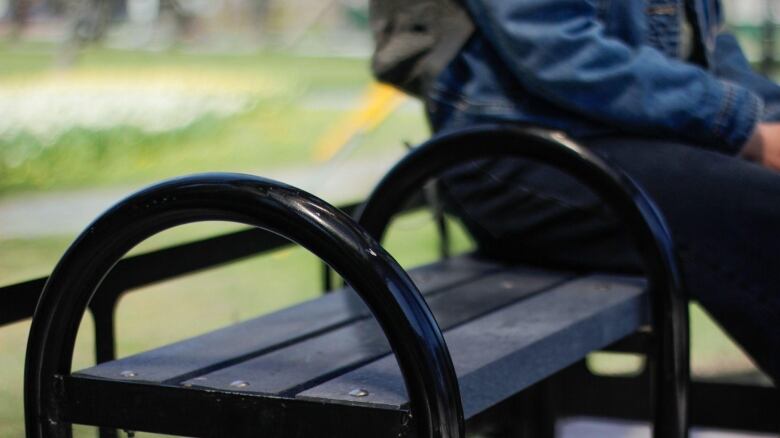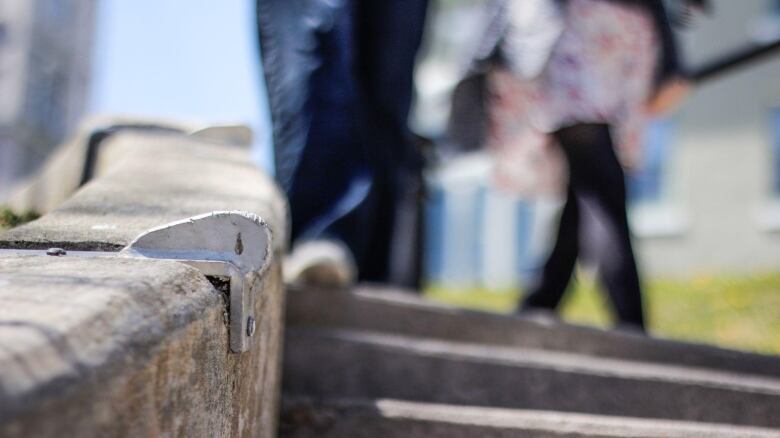St. John's is a friendly place. Our street architecture? Not so much
There are multiple problems with hostile architecture, writes CBC contributor Andie Bulman

For a city with a reputation for being open and friendly, St. John's is teeming with examples of what's called hostile architecture.
These design features tend to blend into our surroundings or conceal their true purpose under a gentle disguise.
Uncomfortable benches with armrests are the best example. The armrest seems to make sense, and it might even make the bench more accessible for some, but sometimes that armrest is meant as a preventive measure; a subtle way of saying, "Don't sleep here."
Many airports and bus stops are big fans of hostile architecture and purposely design their public seating (unyielding, sloped plastic chairs), so folks will sit, but only for a short while, and then quickly move on.
This form of architecture, sometimes called "defensive architecture," isn't a new concept; iron spikes and large fences, in particular, have been used to dictate what happens in public spaces for centuries.
There are multiple problems with hostile architecture. The first and most frivolous? These features take away from a public space's esthetic value rendering it colder, more serious and brusque.
More importantly, hostile architecture seems to assert that public spaces in cities are only for certain population members or have specific, intended uses. St. John's is full of examples of this design style, but it tends to blend into the background. The following are a few examples.
Sectioned benches
Doug Pawson, the executive director of End Homelessness St. John's, always notices the barriers that prevent the most vulnerable from accessing public space.
"I would say that the most common example is sidewalk benches that have arms preventing people from sleeping," said Pawson, who has also noticed spikes in window ledges meant to deter loitering and panhandling.
"I think what's most frustrating about these design elements is that they don't address the problem of homelessness or inequality."

Instead, features like these just moveproblems further down the road.
"In addition to hostile design, we have hostile enforcement of panhandlers," he said. "Any time you police poverty, you're not directing resources to adequately solve it. These are public spaces, and that means everyone should have equal access to use them."
The harbour fence
Architect Chris Woodford, owner ofWoodford Architecture, began his career in Vancouver, where hostile architecture was much more obvious.
"Several of the buildings I worked on there did end up with added pieces of metal around doors and windowsills to prevent people from sleeping. In the firms I worked at this was never actually overtly part of the design," he told me.
"It would often show up a few weeks after the building had already been completed and occupied, presumably at the direction of the developer/owner."

Protecting property was often the justification for these add-ons, but Woodford didn't really buy that explanation: "I've always been of the opinion that underlining this is a desire to keep certain economic groups away."
Woodford has noticed benches and skating clips in St. John's, but to him, the most obvious example of hostile architecture is the controversial metal fence the St. John's Port Authority erected in 2013, on grounds that it was necessary for security for industrial and cruise ships.
"There's nothing subtle about the harbour fence," Woodford said.
"It was a very abrupt turn from the harbour essentially considered to be a sort of public working port to an inaccessible secure industrial zone."
Skate clips
For some people,skateboarding is ahobby they picked up during the pandemic. More folks are gleefully gliding to work than before, but this isn't a city with a historically friendly relationship towardskaters.
Years ago, St. John's city council passed a bylaw that prohibits skateboarding on streets and sidewalks in the downtown core south of LeMarchant Road.
Skateboarder Jared Hawco has noticed a dramatic increase in skate clips small metal buttons or brackets that blend into rails,eliminating smooth lines and making skateboarding more dangerous since that time.

"The old Harbourside Park was a popular skate spot. When the park was renovated and a tiered plaza-style park built, it looked like it would be a great space. However, most flat surfaces were not paved and left as crushed stone, which prevents skateboarding. They also installed skate clips on the concrete ledges."
While some folks might be unmoved by the desires or needs of skateboarders, Hawco points out that using spaces builds community and is infinitely better than empty, unused spaces. He also points out that it's absurd that the downtown core doesn't have a skate park.
"The city only builds skate parks in suburban areas to force skaters out of the core. It's silly. Look at progressive cities such as Copenhagen for examples of urban architectural design that is not only visually appealing, but manages to serve the public and the skateboarding community."
Lack of sidewalks and curb cuts
Meghan Hollett, former chair of Happy City St. John's, says the city's hostile architecture is often most evident in what it lacks.
"I would include the lack of curb cuts, laneways that end abruptly, or a lack of sidewalks," said Hollett, who will be acandidate for councillor-at-large in the fall election.
"Think about MountScio Road. MountScio has no sidewalks at all, despite being home to one of the city's biggest parks, as well as Easter Seals. Yetthere are no sidewalks forfolks to navigate the space. That feels hostile."
Hollettsays that uniformity in itself is hostile.
"We don't all fit into perfect boxes or categories. Benches with and without armrests? Great idea! Architecture needs to serve the community, the whole community. I like to focus onwho is being excluded. Who isn't using the space? How can we get them involved?"
The city, Hollettsays, has taken some great strides forward in recent years.
"While there aren't as many bike racks around as I'd like to see, we are slowly seeing more. We also see more outdoor seating areas that aren't necessarily connected to a store or a space requiring a commercial interaction," she said, adding that Wi-Fi has been available to places like Bannerman Park, which "helpscreate more welcoming and inclusive spaces."













_(720p).jpg)


 OFFICIAL HD MUSIC VIDEO.jpg)
.jpg)



























































































